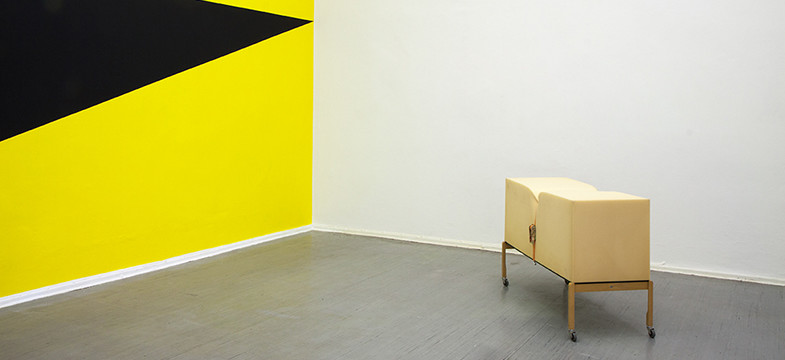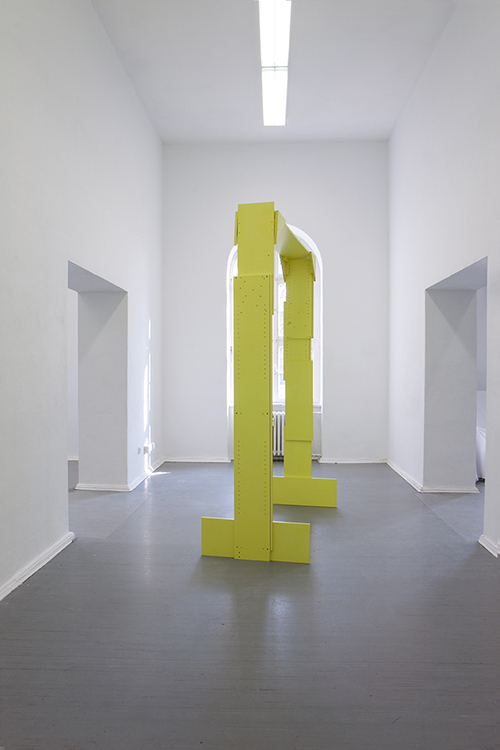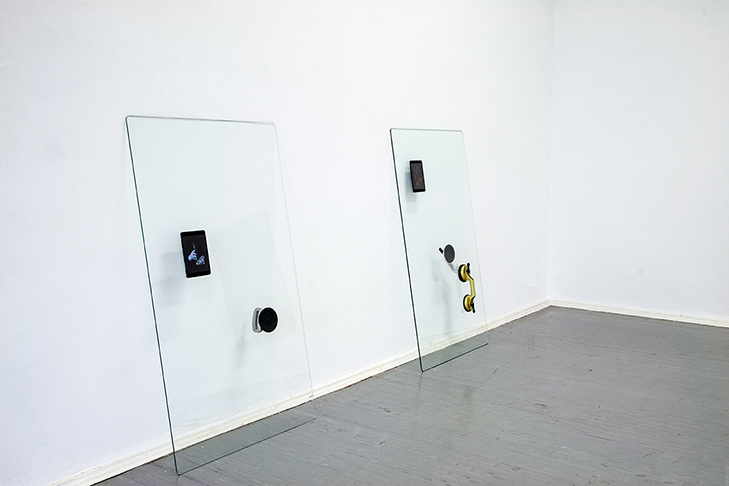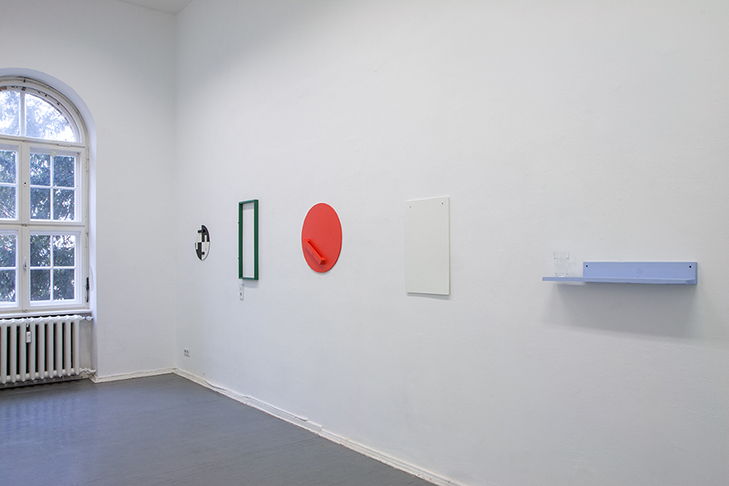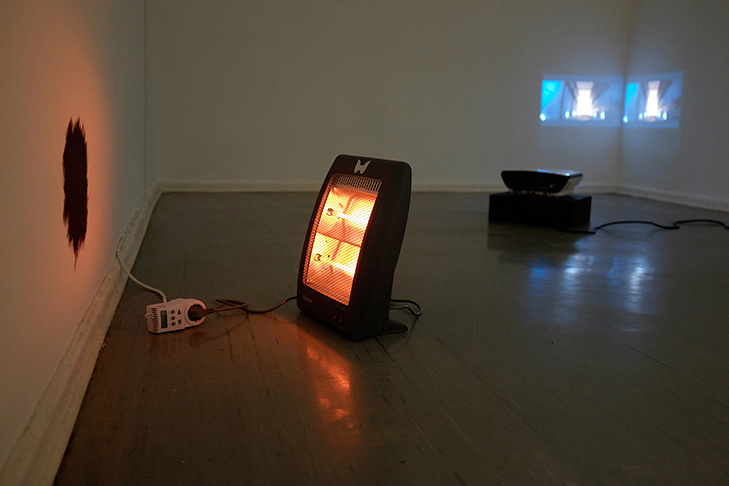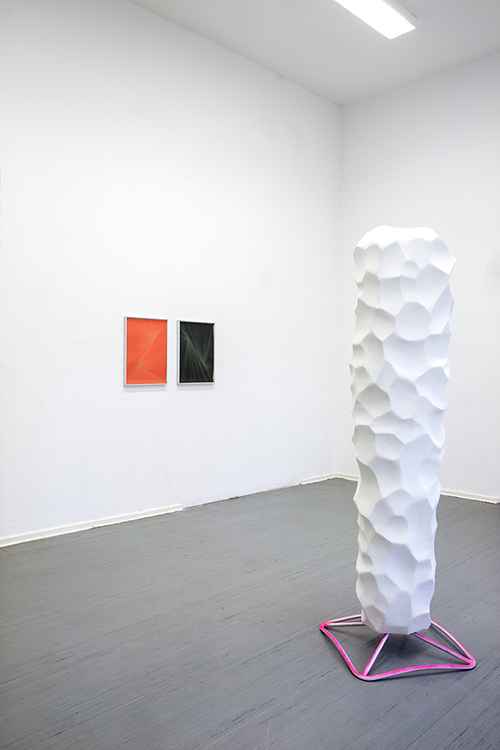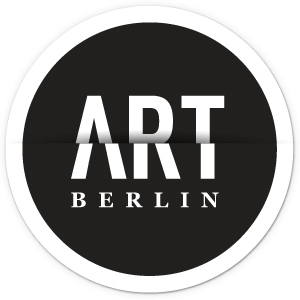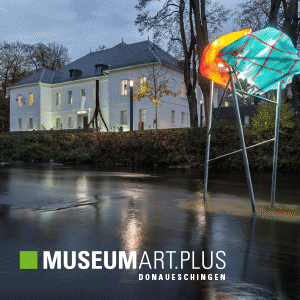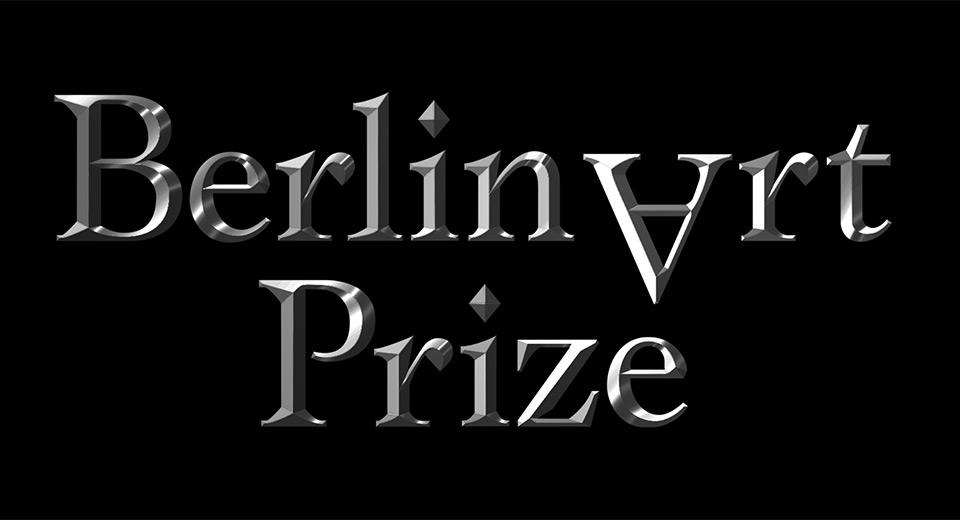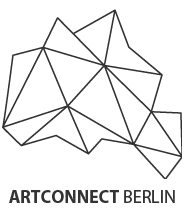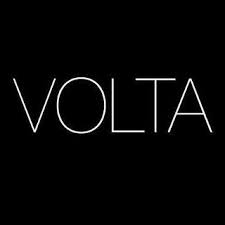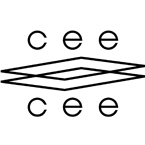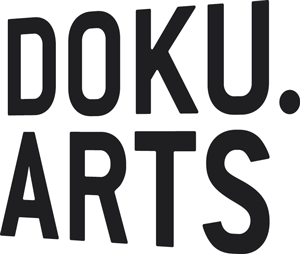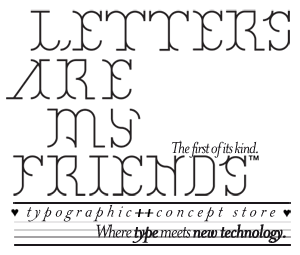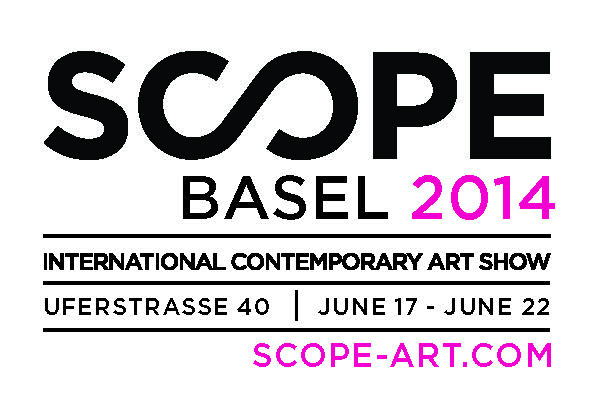Nestled below Oxygen and next to chlorine on the periodic table, sulfur dances along the line between the ordinary and the overwhelming. Today, almost all elemental sulfur enters the world through the altogether quotidian process of natural gas production; in the biblical era, sulfur was known as brimstone — the fundamental building block of hell itself. Hydrogen sulfide gives off the smell of rotting eggs, and “sulfur yellow” anoints the untitled arch poised at the entrance to Setzen Stellen Legen, the group show featuring the work of Sabine Bokelberg, Bert Didillon, Thomas Fischer, Lothar Götz, Katharina Ludwig, and Marie von Heyl.
Didillon’s gateway — installed deliberately askew — looms effervescent in the stark brilliance of the gallery space, showing a little leg. A crude assemblage of Ikea components coming together with ethereal grace, the arch manifests in open space as altogether more than the sum of its parts — a monumental ode to the inscrutability of materials; a chimerical marker of the liminal expanse that exists between art and object; a fitting entrée into the world of Setzen Stellen Legen.
Drifting past the off-kilter arch into the second of six nested spaces, a cluster of shrouded objects hovering in the corner present an unspeakably casual affront to the imprimatur of the gallery space. Dodging the gaze while beguiling the senses, von Heyl’s elusive installation evokes the formal complexity of Christo and Jean-Claude’s wrapped structures at an intimate scale. Presenting a titillating counterpoint to the relaxed obfuscation of the clandestine objects, the remainder of von Heyl’s The Ease of Handling tiptoes along the minimal continuum from the domestic to the industrial and beyond with a series of video installations displayed on iPads, housed in glass and adorned with disconcertingly seductive suction-grip handles.
In each video, a pair of white-gloved hands caressing a beguiling array of objects (from a glass slipper to a ceramic dog) is both devastatingly sensual and improbably hilarious, a cerebral hiccough linking present-day pornography with the physical comedy of charlie chaplain and the savants of the silent age. Slippery, serious, and disturbingly seductive, The Ease of Handling relocates the anomalous object to a realm both breathtakingly close at hand and impossibly distant.
Slipping into the open space alongside The Ease of Handling, Sabine Bokelberg’s o.T. #O6IT, o.T. #SM66, and o.T. #F6OT exert a quiet, looming authority. A thick wash of color universalizes the nomadic wanderings of geometry and texture that overtake the canvases, transforming a familiar medium into an unknown object, redolent of mystery and calling out for exploration. Wandering across the intricate landscape of Bokelberg canvas is akin to getting lost in a new city — magical, illuminating, and deeply addictive.
Through another arch of sorts, a second Didillion work beckons — an untitled series of found objects, arranged alluringly in series, tempting the human tendency to apophenia with an ardent hodgepodge of symbolic miscellany. Anchored by an undeniably celestial, safety-orange circle, Didillon’s objects conjure up desire while defying categorization.
At the far end of the gallery space Katharina Ludwig’s up/melt/burndown—after the fall (Icarus) cavorts with the notion of material reality as a binary state through a series of sculptural, video and sound installations that test the boundaries of the material world. As a space heater blossoms, breathing red heat at an inky wall painting, words appear out of the darkness, only to disappear once more when the glow of the electronic embers fades. Inspired by the conceptual and formal legacy of a fire at a Rolls Royce dealership, up/melt/burndown—after the fall rises up from the ashes, an aesthetic poltergeist haunting a vacant white expanse, flicking on and off the lights, dredging up thoughts in the form of spectral slides printed with enigmatic phrases, and probing beyond the superficial comfort zone inhabited by ordinary objects into the spectral world of transformation.
Sited between Didillon’s sulfurous arch and Ludwig’s immersive haunting, delicate prints by Lothar Götz hang opposite a monumental salt lick of a sculpture from Thomas Fischer; opposite Fischer’s towering white stela, beneath yet another arch, a looming Götz wall painting — resplendent in dazzling yellow, charcoal black and eggplant purple — suffuses the space with a strangely mystical energy, as though the gods of Walt Disney and James Turrell had conspired to bless this particular gallery. Basking in the hallucinatory minimalism of Götz’s Open Plan, an untitled Thomas Fischer sculpture stands calmly at an angle — a rigid, yet supple rectangular block of dense foam atop a rolling table, cinched down the center to form an curiously sensuous cupid’s bow. Imbued by the artist and the installation with a divinely animate quality, Fischer’s sculpture tingles with potentiality, awaiting a limitless number of becomings in the eye of the beholder.
Back in the hallowed entry, tucked well above eye level at a curious angle betwixt the ceiling, the door frame, and a vast white wall, a Thomas Fischer painting calls to the viewer with one last whimsical flash of material wonder — a wooden firmament rendered in saturated hues and sumptuous flatness, one final siren song emanating from the world of Setzen Stellen Legen, in honor of objects.
Setzen Stellen Legen
26.02 – 28.02.2016
Kunstquartier Bethanien
Mariannenplatz 2 10997 Berlin

